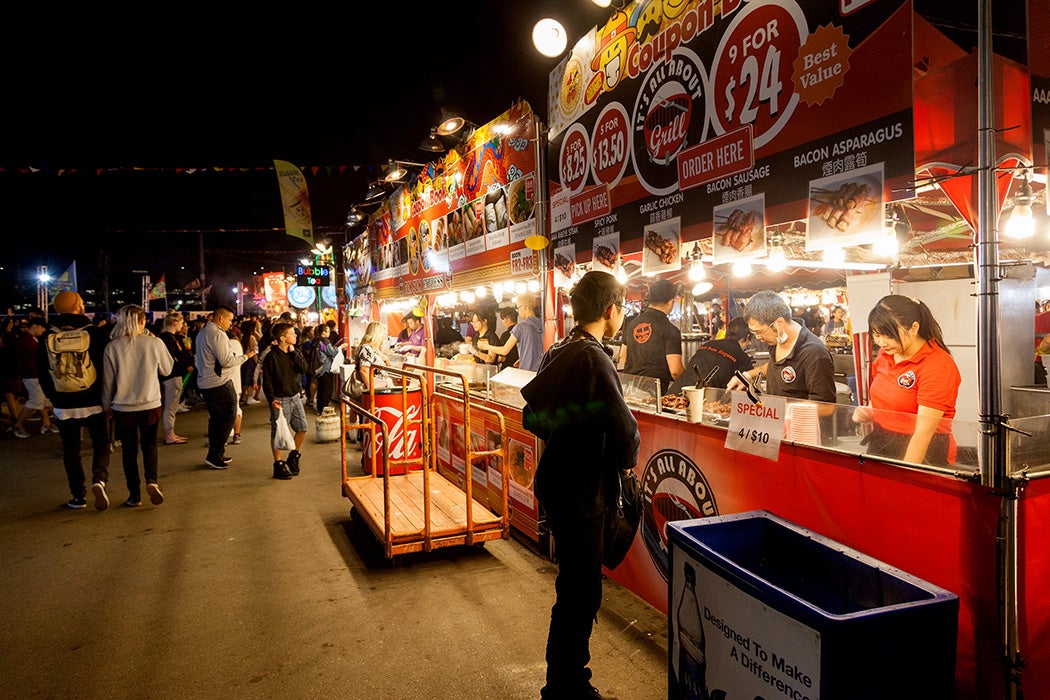Could strolling through a street market resemble a time travel experience? That’s what geographers Yolande Pottie-Sherman and Daniel Hiebert set out to investigate in their study of a Chinese-style night market on the outskirts of metropolitan Vancouver.
Since the 1980s, immigrants from Hong Kong have flocked to the suburb of Richmond, which is now a highly diverse neighborhood, or “ethnoburb,” where about two-thirds of residents are either ethnic Chinese or from other “visible minority” groups—that is, neither Indigenous nor white. Quoting a 2011 blog post from travel guide author Pauline Frommer, Pottie-Sherman and Hiebert note that the suburb is “more like modern Asia than any…encountered in North America.”
“The spatial and temporal realities of suburban life, however, constrain Richmond’s ability to replicate ‘Asia,’” they write. “The active 24/7 culture of Hong Kong, Taiwan and cities of the [People’s Republic of China] is absent in Richmond; malls, restaurants and movie theatres all close early.”
But the Richmond Night Market, designed to appeal to nostalgia for the bustling late-night streets in those cities, is a highly visible exception. Opened in 2000, this Canadian iteration is intended to offer a throwback to “the ‘unquantifiable ambiance’ characteristic across night markets, created through densely packed vendor stalls, narrow paths, smoke, bright lights and displays, shouting, hawking and loud music.”
To understand how suburb-dwelling immigrants navigate a different cultural construction of time, the researchers visited the Richmond Summer Night Market in 2010 and 2011 between May and September, interviewing a variety of organizers, merchants, and market-goers.
“The night market has become a stage for the exploration of conceptions of nostalgia and authenticity. It plays to people’s nostalgia for ‘authentic’ Asia in cultural, but also temporal and spatial senses,” Pottie-Sherman and Hieber conclude from their fieldwork interviews.
Jane, who immigrated as a child, recounts how “‘getting brought to the night market’ was an important way in which her parents ensured that she stay connected to their Hong Kong identity.” Suggesting that Jane’s family’s nostalgia may involve “yearning for an after-dark culture of sociability,” the researchers add that the market can convey “an alternate sense of time.”
The Richmond Night Market also conjures an alternate space, since it “provides a place for people to walk around in Richmond at night, a suburban landscape where most aspects of life are ‘compartmentalized’ by the car.”
But for most shoppers, Richmond’s “out-of-the-way” location means that it requires a special trip to arrive there. In Asia, night markets are “a normalised and ambient part of the urban landscape.” And unlike an open-market concept in Asia, the market in Richmond is demarcated by fences, with attendees funneled through two specific entrances.
The city ordinances that govern vendors also affect the atmosphere. The researchers note that the expected “chaos and disorder” associated with a typical Asian night market wouldn’t be able to break through the “orderly rows and many rules” in Richmond. “Dry-goods vendors cannot put anything outside of their stall and food-court menus are tightly controlled, subject to approval by the administration and health department,” they explain.
Weekly Newsletter
Ultimately, Pottie-Sherman and Hiebert call Richmond’s market “a project in inventing suburban authenticity through a particular interpretation of sociability” in the context of a “super-diverse” society.
“Authenticity is mobilised by the organisers, as well as market-goers,” they explain, “to assert expertise and ownership of the cultural form of the night market. [An] ethnography of the night market reveals how time and space are interwoven into perceptions and experiences of authenticity.”
Support JSTOR Daily! Join our membership program on Patreon today.







